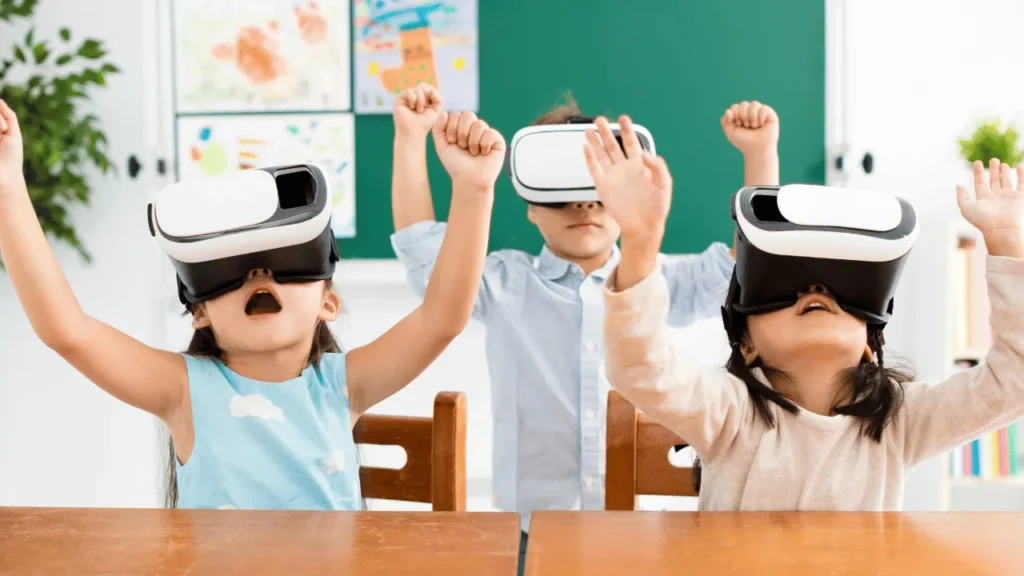In recent years, the integration of environmental education in virtual reality (VR) has emerged as a transformative approach to immersive learning experiences. This innovative technology offers unparalleled opportunities to explore and understand complex environmental concepts dynamically and engagingly. In this article, we delve into the diverse ways in which environmental education in virtual reality can revolutionize the teaching and learning of environmental topics.

Environmental Education in Virtual Reality
Virtual Field Trips:
Environmental education in virtual reality enables students to embark on immersive virtual field trips to ecologically significant locations worldwide without leaving the classroom. With VR headsets, students can explore the Amazon rainforest, the Great Barrier Reef, or the Arctic tundra, experiencing the sights, sounds, and sensations of these diverse ecosystems firsthand. These virtual excursions provide students with a unique opportunity to observe wildlife, study habitat dynamics, and learn about conservation efforts in an immersive setting.
Interactive Simulations:
Virtual reality technology allows for the creation of interactive simulations that enable students to engage with environmental phenomena in real-time. Through environmental education in virtual reality, students can manipulate variables such as temperature, precipitation, and greenhouse gas emissions to simulate the effects of climate change on ecosystems. They can observe how changes in environmental conditions impact wildlife populations, vegetation patterns, and natural resource availability, gaining a deeper understanding of environmental systems.
Environmental Monitoring and Data Visualization:
Environmental education in virtual reality facilitates the visualization of complex environmental data in intuitive and immersive ways. By representing datasets as 3D models or interactive visualizations, VR enables students to explore environmental trends, patterns, and spatial relationships with unprecedented clarity. For example, students can visualize global temperature changes, deforestation rates, or air pollution levels, gaining insights into environmental issues and trends that would be challenging to convey using traditional teaching methods.
Virtual Laboratories:
Virtual reality technology allows for the creation of virtual laboratories where students can conduct experiments, analyze data, and explore scientific concepts in a simulated environment. Through environmental education in virtual reality, students can simulate the effects of pollution on water quality by conducting virtual water quality tests and monitoring changes in pH, turbidity, and dissolved oxygen levels. These virtual experiments provide students with hands-on learning experiences that deepen their understanding of environmental science concepts and principles.
Conservation and Advocacy:
Environmental education in virtual reality can raise awareness about environmental issues and promote conservation efforts through immersive experiences. Students can participate in virtual expeditions to study endangered species, track deforestation in rainforests, or monitor coral bleaching on coral reefs. These experiences foster empathy, engagement, and environmental stewardship, inspiring students to take action to protect the planet and its biodiversity.
10 Interactive Virtual Environmental Learning Platforms
1. EcoRise in Virtual Reality:
EcoRise offers K-12 students immersive modules, virtual field trips, and interactive projects to learn about sustainability in virtual reality. For example, students can explore renewable energy concepts by designing virtual solar panels or learn about water conservation through interactive simulations of rainwater harvesting systems.
2. EarthEcho Expeditions in Virtual Reality:
EarthEcho Expeditions provides virtual reality experiences for students to explore environmental issues worldwide. Students can embark on virtual expeditions to the Amazon rainforest, the Arctic tundra, or coral reefs, immersing themselves in virtual environments to learn about biodiversity, climate change, and conservation efforts.
3. WildEarth Virtual Safaris:
WildEarth streams live safaris and wildlife experiences in virtual reality from various locations worldwide. Students can join virtual safaris to observe wildlife behavior in real-time, such as watching elephants in Africa or tracking polar bears in the Arctic, enhancing their understanding of ecosystems and conservation.
4. EarthXplorer Virtual Tours:
EarthXplorer offers virtual reality tours of iconic natural landmarks and conservation sites. Students can explore virtual environments like the Amazon rainforest, the Great Barrier Reef, or national parks, gaining insights into environmental issues and conservation efforts through immersive experiences.
5. Explore. org Live Streams in Virtual Reality:
Explore. org provides live-streaming videos of wildlife and nature in virtual reality. Students can watch live feeds of animals in their natural habitats, such as bears in Alaska or penguins in Antarctica while learning about ecosystems, biodiversity, and conservation efforts.
6. National Geographic Education Virtual Resources:
National Geographic Education offers virtual reality resources, including interactive maps, 360-degree videos, and virtual field trips. Students can explore virtual environments like coral reefs, rainforests, or glaciers, gaining a deeper understanding of environmental issues and geographic concepts.
7. Virtual Marine Biology Lab Experiments:
Virtual Marine Biology Lab offers interactive experiments and simulations for students to explore marine ecosystems in virtual reality. Students can conduct virtual experiments to study coral reef dynamics, ocean acidification, and marine biodiversity, enhancing their understanding of marine science concepts.
8. Virtual Forest Ecology Lab Explorations:
Virtual Forest Ecology Lab allows students to explore virtual forests and learn about forest ecosystems in virtual reality. Students can analyze tree species diversity, study nutrient cycling processes, and investigate the impacts of deforestation through immersive simulations and data visualization tools.
9. Climate Interactive Simulations in Virtual Reality:
Climate Interactive provides interactive simulations and models in virtual reality to help students understand climate change dynamics. Students can explore virtual environments to simulate climate change scenarios, assess mitigation strategies, and analyze the potential impacts of climate policies.
10. Ocean School Virtual Learning Experiences:
Ocean School offers virtual reality lessons and experiences for students to learn about ocean science and conservation. Students can explore virtual underwater habitats, study marine species, and engage in ocean conservation activities, promoting ocean literacy and stewardship in virtual reality.
These 10 interactive virtual environmental learning platforms in virtual reality offer immersive and engaging experiences for students to explore and learn about environmental concepts.

How Effective is Virtual Environmental Learning in Engaging Students
Environmental education in virtual reality (VR) has emerged as a powerful tool for engaging students in immersive learning experiences. Here’s why environmental education in virtual reality is so effective:
Immersive Experiences: Environmental education in virtual reality transports students to different ecosystems and locations worldwide, providing them with immersive experiences that enhance their engagement and understanding of environmental concepts. By simulating environments such as rainforests, coral reefs, and polar ice caps, virtual reality creates a sense of presence that captivates students’ attention and fosters exploration.
Interactive Learning: Virtual reality platforms for environmental education offer interactive elements such as simulations, virtual experiments, and quizzes. These interactive features allow students to actively participate in their learning process, engaging with the content in a hands-on manner. Through virtual experiments and simulations, students can observe cause-and-effect relationships in real time, which deepens their understanding of environmental concepts.
Real-Time Feedback: Environmental education in virtual reality provides students with real-time feedback and assessment tools, allowing them to track their progress and performance as they engage with the content. This immediate feedback helps students monitor their understanding of the material and identify areas for improvement. By offering feedback in real-time, virtual reality platforms facilitate continuous learning and skill development.
Multi-Sensory Engagement: Environmental education in virtual reality engages multiple senses, including sight, sound, and sometimes even touch. By appealing to different sensory modalities, virtual reality creates a rich and immersive learning environment. For example, students may hear the sounds of birds chirping in a virtual forest or feel the sensation of swimming underwater in a virtual ocean, which enhances their overall engagement with the content.
Accessibility and Flexibility: Environmental education in virtual reality is highly accessible and flexible, allowing students to engage with the content from anywhere with an internet connection. This accessibility enables students to learn at their own pace and on their own schedule, accommodating diverse learning needs and preferences. Additionally, virtual reality platforms offer flexibility in content delivery, allowing educators to customize the learning experience to suit their students’ needs.
Environmental education in virtual reality is an effective tool for engaging students in immersive learning experiences.
Are There Any Virtual Environmental Learning Communities or Forums
These platforms provide opportunities for educators, students, researchers, and environmental enthusiasts to engage in discussions, access educational materials, and participate in virtual events focused on environmental education in virtual reality. Here are some examples of virtual environmental learning communities and forums:
1. Environmental Education Association of New Mexico (EEANM) Virtual Community: EEANM offers a virtual community for environmental educators in New Mexico to connect, share resources, and collaborate on environmental education initiatives using virtual reality. The platform provides access to webinars, forums, and online resources to support professional development and networking among educators interested in integrating virtual reality into their teaching practices.
2. Virtual Learning Network for Environmental Educators (VLN): VLN is an online community for environmental educators to exchange ideas, resources, and best practices in environmental education using virtual reality. The platform hosts virtual forums, workshops, and conferences where members can discuss current issues, share teaching strategies, and collaborate on projects that utilize virtual reality technology.
3. North American Association for Environmental Education (NAAEE) Online Community: NAAEE provides an online community for environmental educators across North America to connect and collaborate on virtual reality-based environmental education initiatives. The platform features discussion forums, virtual events, and resource libraries where members can share ideas, access educational materials, and engage in professional development opportunities focused on integrating virtual reality into environmental education.
4. International Society for Technology in Education (ISTE) Environmental Education Network: ISTE offers an environmental education network for educators interested in leveraging virtual reality technology in their environmental education efforts. The network provides virtual forums, webinars, and online resources to support educators in using virtual reality to enhance environmental learning experiences for students.
5. Environmental Education Online Community (EECO): EECO is an online community for environmental educators in Ontario, Canada, to share resources, collaborate on projects, and engage in professional development using virtual reality technology. The platform hosts virtual forums, workshops, and networking events where members can exchange ideas and support each other in integrating virtual reality into their environmental education programs.
These virtual environmental learning communities and forums offer valuable opportunities for individuals to connect with like-minded peers, access resources, and stay informed about current trends and developments in environmental education using virtual reality.
Environmental education in virtual reality offers a transformative approach to teaching and learning environmental concepts, providing students with immersive, interactive, and experiential learning experiences. By leveraging VR technology, educators can engage students in meaningful exploration of environmental topics, promote inquiry-based learning, and inspire action to address pressing environmental challenges. As environmental education in virtual reality continues to evolve and become more accessible, its potential to revolutionize environmental education is boundless, offering new avenues for fostering environmental literacy, stewardship, and sustainability.
